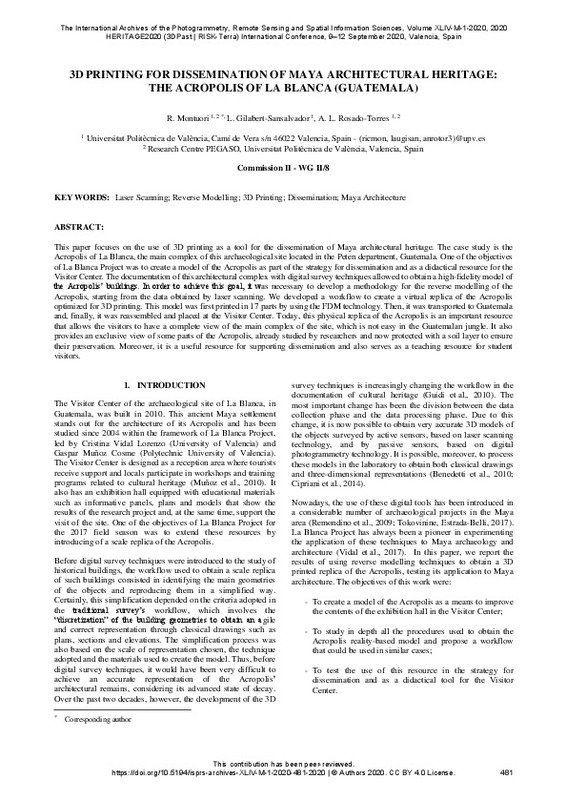Montuori, R.; Gilabert Sansalvador, L.; Rosado-Torres, AL. (2020). 3D Printing for Dissemination of Maya Architectural Heritage: The Acropolis of La Blanca (Guatemala). International Archives of the Photogrammetry, Remote Sensing and Spatial Information Sciences (Online). 44:481-488. https://doi.org/10.5194/isprs-archives-XLIV-M-1-2020-481-2020
Por favor, use este identificador para citar o enlazar este ítem: http://hdl.handle.net/10251/169145
|
Título:
|
3D Printing for Dissemination of Maya Architectural Heritage: The Acropolis of La Blanca (Guatemala)
|
|
Autor:
|
 Montuori, Riccardo
Montuori, Riccardo

 GILABERT SANSALVADOR, LAURA
GILABERT SANSALVADOR, LAURA
 Rosado-Torres, Ana Laura
Rosado-Torres, Ana Laura
|
|
Fecha difusión:
|
|
|
Resumen:
|
[EN] This paper focuses on the use of 3D printing as a tool for the dissemination of Maya architectural heritage. The case study is the Acropolis of La Blanca, the main complex of this archaeological site located in the ...[+]
[EN] This paper focuses on the use of 3D printing as a tool for the dissemination of Maya architectural heritage. The case study is the Acropolis of La Blanca, the main complex of this archaeological site located in the Peten department, Guatemala. One of the objectives of La Blanca Project was to create a model of the Acropolis as part of the strategy for dissemination and as a didactical resource for the Visitor Center. The documentation of this architectural complex with digital survey techniques allowed to obtain a high-fidelity model of the Acropolis¿ buildings. In order to achieve this goal, it was necessary to develop a methodology for the reverse modelling of the Acropolis, starting from the data obtained by laser scanning. We developed a workflow to create a virtual replica of the Acropolis optimized for 3D printing. This model was first printed in 17 parts by using the FDM technology. Then, it was transported to Guatemala and, finally, it was reassembled and placed at the Visitor Center. Today, this physical replica of the Acropolis is an important resource that allows the visitors to have a complete view of the main complex of the site, which is not easy in the Guatemalan jungle. It also provides an exclusive view of some parts of the Acropolis, already studied by researchers and now protected with a soil layer to ensure their preservation. Moreover, it is a useful resource for supporting dissemination and also serves as a teaching resource for student visitors.
[-]
|
|
Palabras clave:
|
Laser Scanning
,
Reverse modelling
,
3D printing
,
Dissemination
,
Maya architecture
|
|
Derechos de uso:
|
Reconocimiento (by)
|
|
Fuente:
|
International Archives of the Photogrammetry, Remote Sensing and Spatial Information Sciences (Online). (eissn:
2194-9034
)
|
|
DOI:
|
10.5194/isprs-archives-XLIV-M-1-2020-481-2020
|
|
Editorial:
|
Copernicus Publ.
|
|
Versión del editor:
|
https://doi.org/10.5194/isprs-archives-XLIV-M-1-2020-481-2020
|
|
Título del congreso:
|
HERITAGE2020 (3DPast | RISK-Terra), International Conference on Vernacular Architecture in World Heritage Sites. Risks and New Technologies
|
|
Lugar del congreso:
|
Valencia, España
|
|
Fecha congreso:
|
Septiembre 09-12,2020
|
|
Código del Proyecto:
|
info:eu-repo/grantAgreement/GVA//GRISOLIAP%2F2018%2F139/
info:eu-repo/grantAgreement/UPV//AD1915/
info:eu-repo/grantAgreement/UPV//PAID-01-17/
info:eu-repo/grantAgreement/MINECO//BES-2015-071296/ES/BES-2015-071296/
info:eu-repo/grantAgreement/AEI/Plan Estatal de Investigación Científica y Técnica y de Innovación 2017-2020/PGC2018-098904-B-C21/ES/ARQUITECTURA MAYA: SISTEMAS CONSTRUCTIVOS, ESTETICA FORMAL, SIMBOLISMO Y NUEVAS TECNOLOGIAS/
|
|
Agradecimientos:
|
This work was funded by the Universitat Politècnica de
València through the Research and Development Grants
Program (PAID-01-17); by the Spanish Ministry of Science,
Innovation and Universities through the Aid Program for ...[+]
This work was funded by the Universitat Politècnica de
València through the Research and Development Grants
Program (PAID-01-17); by the Spanish Ministry of Science,
Innovation and Universities through the Aid Program for predoc contracts for the training of doctors (ref. BES-2015-
071296) and by Generalitat Valenciana through the Santiago
Grisolía grants Program (GRISOLIAP/2018/139).
This study is also part of the research project Arquitectura
Maya: Sistemas Constructivos, Estética Formal, Simbolismo y
Nuevas Tecnologías (PGC2018-098904-B-C21-AR), funded
by the Spanish Ministry of Science, Innovation and
Universities.
[-]
|
|
Tipo:
|
Artículo
Comunicación en congreso
|









